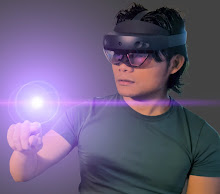The specific technology focus that an MRDT (i.e. component/asset twin in hologram form) brings can almost fit snugly into the four human-technology-world relations. These are categorised notions that have been observed which various technologies bring about, when the human (subject) and the specific technology (object) meet. MRDTs, as their own entity, fit the bill of all four, whereas previous examples present different technologies for each of these notions. An MRDT dynamically and vividly manifests all four. Let’s consider each one.
Embodiment Relations
For the “embodiment relations”, where the classic eyeglass technology integrates seamlessly, embodied as it is used. As Ihde describes,
“I relate to my environment, my world,” by means of such technologies, and if they are well functioning, then experientially they are “taken into my very sense of bodily experience.” My awareness of wearing glasses is a fringe awareness that gets interrupted only when there is back glare, or when the glasses slip off my nose, or when the lenses get dirty and smudged, when, in other words, something diminishes the normative transparency of the optics” (Ihde, 2012, p. 244).
This week, I was looking at the state of mixed reality (MR). MR is an immersive medium for experiencing media. It is a blend of the real physical environment with interactable 3D virtual artefacts. Headsets that can facilitate this are the likes of HoloLens and the HoloLens 2, where the user engages with the (still) bulky, computerised smart glasses. As Ihde remarks, however, wearing his glasses “is a fringe awareness,” but the HoloLens 2 is more than noticeable. It isn’t altogether invisible to the user wearing it, and also to the observer who might take more notice of someone when their eyeglasses are removed from their face, the familiar face that always incorporates eyeglasses as part of their bodily feature. It might still be embodied in the sense that their perception has been augmented, imbuing them with another sense, one that can perceive greater detail thanks to visualised data streaming through it.

Hermeneutic Relations
Interpreting the “readouts” of technology.

Alterity Relations
This “quasi-other” entity. We talk with and treat some technologies as if they were another human.
Background Relations
The invisible and responsible infrastructure that affects our experience in and of the world.
